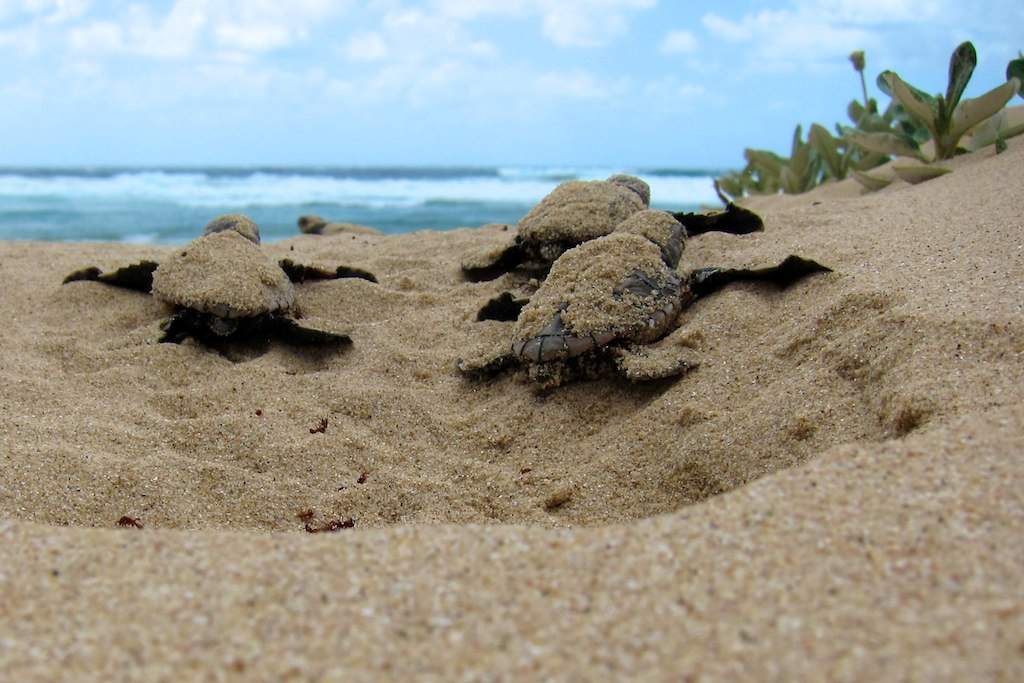Wet beaches drown sea turtles
Climate change makes beaches wetter, hurting the survival of sea turtle hatchlings
Lydia Chain • October 24, 2014

These successful hatchlings are on their way to the ocean. [Image credit: Flickr user Jeroen Looye]
Climate changes may be wreaking havoc on the beaches where leatherback sea turtles nest. As sea levels rise and rain pounds on the sand, sea turtle nests get soggy. This could spell trouble for the charismatic reptile, which at six feet long, is the largest living turtle.
Sea turtles bury their eggs deep in the sand, but when the nest is too wet oxygen can’t reach the eggs. The embryos suffocate. Scientists have known about the effect of excess moisture on sea turtle nests for some time, but no study directly links the problem to climate change. New research conducted on La Playona Beach in Colombia, a major leatherback nesting zone, makes that connection. The research was done in such an inexpensive, intuitive way that scientists around the world say it could be easily reproduced to give comprehensive conservation advice to save the sea turtles.
Like many leatherback haunts, this Caribbean beach is extremely isolated. The scientists could only reach the site in the wooden boats of local fishermen. “The use of sophisticated scientific machines was almost impossible,” said the study’s co-author, Adolfo Marcos, a marine biologist at the Doñana Biological Station in Seville, Spain. “We had to find very simple solutions to solve many logistical problems.”
Marcos and his colleagues monitored 39 leatherback nests on La Playona Beach. They took samples of sand beside each nest to determine the water saturation around the eggs. Since the team did not have access to machines to analyze moisture levels, they simply allowed the sand samples to sit on scales in the hot sun. As water evaporated, the researchers determined water saturation by subtracting the sand’s final from initial weight.
To help correct for variation in field conditions, like shade and sand composition, the team took 30 nests deemed “doomed,” in an area with a high risk of human destruction, and transported them to a hatchery to be incubated in lab conditions. Here, they artificially controlled water content of the sand as the eggs incubated.
Under field and lab conditions, the scientists counted the number of live hatchlings that emerged. They then unearthed the nests to count the embryos that never hatched. Together, these numbers provided an overall survival rate for each incubation condition. A clear trend emerged: the wetter the sand, the lower the survival rate. On the wettest parts of the beach, no hatchlings survived at all.
These results, which will be published in the December issue of the Journal of Experimental Marine Biology and Ecology, are not entirely surprising to scientists. According to Richard Reina, a marine biologist at Monash University in Melbourne, Australia, the connection between climate change and lower hatchling survival rate was a “fairly easy inference to draw,” given previous knowledge of climate change’s effects on beach moisture.
Nevertheless, researchers praised the low-tech and low-cost methodology, which will allow other scientists to check if this finding occurs globally. “This is a template that could be rolled out at other sites around the world,” said Graeme Hays, a professor of marine science at Deakin University in Melbourne, Australia.
But marine conservationists won’t rush to move leatherback nests to drier beaches just yet. The temperature of the nest determines the sex of a sea turtle, and drier sand means hotter sand. Moving nests, however well intentioned, could disrupt the sex ratio, researchers say. “It risks a 100 percent female population,” said Gail Schofield, a marine biologist also at Deakin University. Changing the balance of males and females could hurt the leatherback population even more than the climate changes.